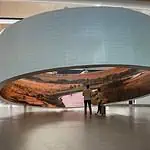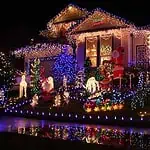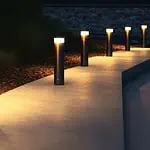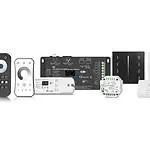LED tunnel lights have transformed tunnel illumination, offering numerous benefits compared to traditional lighting. These advanced fixtures are designed for tunnel use and employ light-emitting diodes (LEDs), outperforming older technologies like incandescent or fluorescent bulbs. LED lighting’s exceptional brightness and high lumen output ensures better visibility and safety for motorists, reducing accidents and improving the overall user experience.
Key Features of LED Tunnel Lighting Fixtures
Energy Efficiency: LED Tunnel Lighting’s Powerhouse
LED tunnel lighting fixtures, utilizing LEDs with high-lumen output, are revolutionizing the world of energy efficiency. These modern marvels consume significantly less power than their traditional counterparts, making them a more cost-effective solution for illuminating tunnels. But that’s not all – these energy savings also translate into reduced operational costs. Imagine slashing your electricity bill in half by switching to LED tunnel lights! That’s precisely what many organizations have experienced after making the switch.
Long Lifespan: The Endurance Champion of Lighting
With an impressive lifespan of up to 100,000 hours, LED tunnel lights boast minimal maintenance and replacement requirements. This longevity means fewer maintenance disruptions and lower power consumption for tunnel operators using tight fixtures. Just think about it – with such a stable light source, you’ll save time and money on labor, not to mention the hassle of constantly changing out burnt-out bulbs!
Enhanced Visibility: Safety First in Tunnel Lighting
High-quality LED tunnel lights provide uniform illumination that reduces glare and improves overall driver visibility, making it safer for motorists. This enhanced level of safety is essential when navigating through dark tunnels at high speeds. No more squinting or straining your eyes while driving through poorly lit tunnels with tight fixtures! With LED technology, you can rest assured knowing that everyone on the road has clear visibility, leading to safer journeys for all.
Instant On/Off Functionality: Ready When You Are
Unlike conventional lighting systems that require warm-up time, LED tunnel lights reach full brightness instantly. This feature allows for immediate response to changing conditions or emergencies within the tunnel environment, even in cases of voltage drop. Imagine a sudden power outage or emergency – with instant on/off functionality, and LED lights will be ready to go when needed most, providing critical illumination during crucial moments.
Durability & Resistance: Built Tough for Challenging Conditions
Designed specifically for harsh environments, LED tunnel lighting fixtures offer resistance against vibrations, extreme temperatures, and moisture. These sturdy LEDs ensure reliable performance, even when faced with the most challenging conditions and voltage drops. So whether it’s cold or scorching hot outside, you can trust that your LED tunnel lights will continue to shine brightly and consistently with the support of reliable power supplies.
Smart Control Integration: The Future of Tunnel Lighting
LED tunnel lights featuring LEDs, power supplies, and wires are more than just energy-efficient and durable; they’re also incredibly adaptable. These advanced lighting systems can be easily integrated with intelligent control systems for remote monitoring, dimming capabilities, and energy management optimization. This seamless integration allows even greater efficiency and adaptability within the tunnel environment while maintaining the desired CCT.
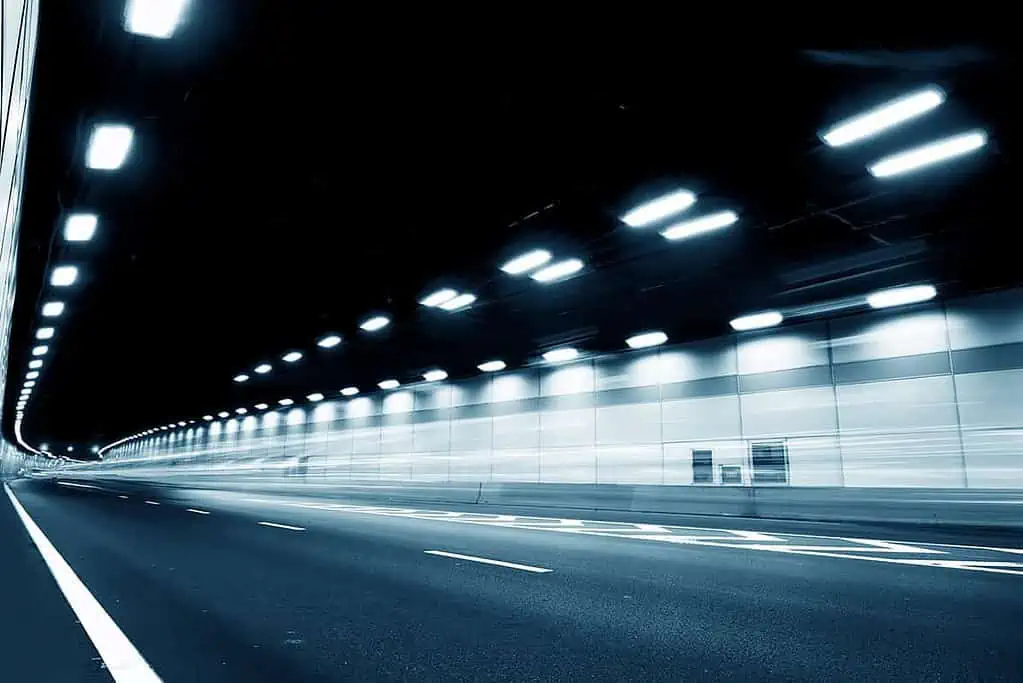
Types of LED Tunnel Lights and Applications in Tunnels
Versatile Applications for Every Tunnel Type
LED tunnel lights, powered by efficient power supplies, are perfect for various tunnels, including road, railway, and pedestrian ones. These lighting solutions, which use high-quality LEDs, ensure that everyone using the tunnel has optimal visibility with the appropriate CCT, making their journey safer and more enjoyable. For instance, in road tunnels, LED lights can help drivers clearly see the road ahead and avoid potential accidents. Similarly, these lights illuminate railway tunnels through well-connected wires for train operators to navigate safely. Pedestrian tunnels also benefit from LED lighting by creating a well-lit environment that encourages people to use them without fear of danger.
Slash Energy Costs with Efficient Lighting Solutions
One of the primary advantages of LED tunnel lights is their energy efficiency. These lights consume significantly less power than traditional lighting options while maintaining a long lifespan, reducing the voltage drop across wires. This means that over time, they save on energy costs and reduce maintenance requirements – a win-win situation for tunnel operators and users alike! For example, studies have shown that switching to LED lighting can save up to 50% of energy compared to conventional systems. Furthermore, with an average lifespan of 50,000 hours or more (compared to 10-15 thousand hours for traditional lamps), LEDs require fewer replacements and maintenance interventions, providing better services to the channel. For more information, you can read Lumen to Watts: The Complete Guide.
Tailor-Made Options for Specific Tunnel Needs
LED tunnel light manufacturers offer designs for specific tunnel dimensions and lighting needs, including LEDs, power supplies, and channel options. Some popular styles include:
- Linear: Ideal for long tunnels where continuous LED light illumination is required. Light sources such as LED wall packs provide adequate light.
- Modular: Comprised of multiple units, such as led light sources or led strips, that can be combined or separated according to the desired brightness level in LEDs.
- Floodlight: Provides focused illumination in specific areas within the tunnel using LEDs, an led controller, and a channel.
These customizable options, including LEDs, power supplies, and individual led, allow engineers and architects to create tailored lighting solutions that meet each project’s unique requirements.
Safety First: Advanced Features Enhance Tunnel Environments
In addition to their energy-saving benefits, LED tunnel lights boast advanced features designed specifically for safety. One such feature is glare reduction, which minimizes the harshness of light and prevents blinding effects on drivers and pedestrians. This is particularly important in road tunnels, where sudden changes in lighting conditions, voltage drops, and power supplies can cause accidents. The use of LEDs and a stable power supply ensure the safety of all users.
Another innovative technology in LED tunnel lights is adaptive lighting control systems, which involve LEDs, power supplies, and controllers. These systems use sensors to monitor the tunnel’s ambient light levels and adjust the brightness accordingly, considering factors such as voltage drop. For example, when natural light enters the tunnel entrance during the daytime, the system may reduce artificial lighting intensity to save energy while maintaining safe visibility conditions.
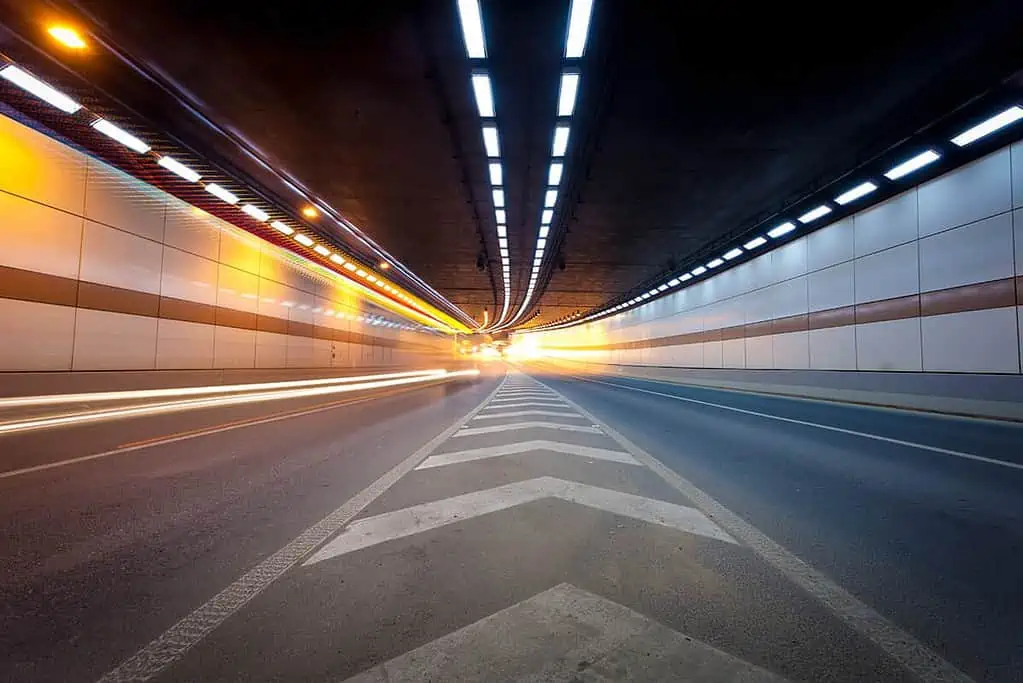
Choosing the Right LED Tunnel Light for Specific Needs
Selecting the right LED tunnel light and power supplies for specific needs is akin to choosing the correct footwear for a challenging hike — you need the right tool for the job. Here are some tips and considerations to guide you on this illuminating journey, taking into account factors like voltage drop and the importance of reliable LEDs:
1. Consider the Brightness and Color Temperature:
Just like you wouldn’t use a single candle to illuminate a vast, dark cave, the brightness, measured in lumens, and the color temperature, measured in Kelvins (K), are critical when choosing tunnel lighting. Brightness must be sufficient to ensure safety and visibility. LED tunnel lights, or LEDs, typically range from 5,000 to 20,000 lumens, depending on the size and purpose of the tunnel. Additionally, voltage drop and power supplies should be considered when selecting the appropriate power supply for these tunnel lights.
As for color temperature, cooler light (5000K or above) often makes the most sense for tunnels as it closely mimics daylight, providing a clear, alerting light that aids in concentration, an essential factor for drivers or pedestrians using the tunnel.
2. Check the Beam Angle:
Choosing a beam angle for your LED tunnel lights is like deciding where to cast your fishing line — it can significantly affect your success. A wider beam angle distributes light over a larger area with less intensity, while a narrow beam focuses the light, resulting in a more intense but concentrated illumination. The right choice depends on the tunnel’s size and shape, the desired light distribution, and factors such as voltage drop and power supply requirements.
3. Energy Efficiency:
Like choosing a fuel-efficient car for a cross-country road trip, picking energy-efficient LED tunnel lights is crucial. LED lights already offer substantial energy savings compared to traditional lighting. Still, you can optimize this further by looking at the lumens per watt (lm/W) ratio, which tells you how much light you get for each watt of electricity used. These LED lights’ voltage and power supply requirements will also ensure optimal performance and energy efficiency.
4. Lifespan:
A key advantage of LED tunnel lights, similar to a well-built piece of furniture, is their longevity. A quality LED tunnel light with a stable power supply and efficient controller can last up to 50,000 hours or more. This reduces the frequency of replacements, offering long-term cost savings, especially in a high-usage environment like a tunnel where voltage fluctuations can affect the performance of LEDs.
5. Durability and IP Rating:
Tunnels can be harsh environments. They’re like the ever-changing weather patterns of the high seas — susceptible to dampness, dust, temperature fluctuations, and more. Therefore, choosing LED tunnel lights with a high Ingress Protection (IP) rating is crucial, indicating their resistance to dust and water.
6. Choose Lights with Easy Maintenance:
Just like you’d prefer a low-maintenance garden, opting for LED tunnel lights with efficient LEDs, a power supply, and a controller that are easy to clean and maintain can save a lot of effort in the long run. Consider dust- and water-resistant designs that allow for easy access when it’s time to replace the lights.
Remember, the goal is to choose a reliable, long-lasting light that fits the tunnel’s requirements. Remember to consult with a lighting expert or an engineer to ensure you’re making the best choice for your specific situation, considering the power supply and voltage.
LED Tunnel Light Layout, Optic Design, and Installation
Mastering LED Tunnel Light Layout
LED tunnel light layout is crucial to any successful tunnel lighting project. This involves considering the tunnel’s dimensions, such as length, width, and height, to determine the optimal placement of light fixtures, voltage requirements, power supply, and controller. By doing so, you can ensure that your lighting system provides maximum illumination while remaining energy efficient. It’s all about finding that sweet spot where your lights are bright enough but not overwhelming or wasteful.
For instance, consider a case study where engineers had to design a lighting system for a 500-meter-long tunnel with varying widths and heights. They used computer simulations to determine the ideal placement of LED fixtures, voltage, power supply, and controller along the tunnel walls and ceiling. The result was an evenly illuminated environment that maximized visibility while minimizing energy consumption using LED tunnel lights.
Optic Design: The Key to Glare-Free Illumination
Customizing the optical design of your LED tunnel light fixtures is essential for achieving optimal light distribution and intensity. This means selecting appropriate lenses, reflectors, and diffusers that work with the LED chips, power supply, and voltage to provide uniform, glare-free illumination. A well-designed optic system can make all the difference in creating a safe environment for drivers navigating through tunnels.
For example, one innovative optic design technique involves prismatic lenses that redirect light from individual LED tunnel light to specific angles or patterns. This reduces glare by ensuring that light is directed precisely where it’s needed most without spilling over into unnecessary areas while optimizing voltage and power supply requirements.
Installation: Secure Your Lighting Fixtures
A secure and stable installation of your LED tunnel lighting fixtures is vital for preventing potential hazards and prolonging their lifespan. To achieve this stability, use high-quality mounting brackets, wires, and fasteners during installation. Properly installed fixtures with a reliable power supply will remain firmly in place even under harsh conditions like vibrations from passing vehicles or extreme weather events.
Take note of an incident where improper installation and voltage caused several LED tunnel lights to fall from the ceiling, resulting in costly damages and posing a significant safety risk. You can avoid such issues by investing in quality installation materials and power supply and following best practices for securing LED tunnel lights.
LED Controllers: The Brains Behind the Operation
Incorporating an advanced LED controller and power supply into your lighting project enables easy management of light intensity, color temperature, voltage, and operational modes for LED tunnel light. This provides better control over energy consumption and maintenance costs while enhancing tunnel safety. Imagine adjusting your tunnel’s lighting system remotely or automatically based on real-time data like traffic flow or weather conditions – that’s what an LED controller can do for you.
Maintenance Matters: Keep Your Lights Shining Bright
Regularly inspecting and upkeep your LED tunnel lighting fixtures, power supply, and other components are essential for optimal performance and preventing potential issues. This includes cleaning lenses, checking wires for damage or wear, and replacing faulty parts, such as voltage regulators.
For example, consider the story of a city that implemented a proactive maintenance program for its tunnel lighting system. By regularly inspecting their LEDs, power supply, and voltage and addressing any issues with the strips before they become significant problems, they could extend the lifespan of their lights by several years while saving money on replacement costs.
So there you have it – mastering these aspects of LED tunnel light layout, optical design, installation, power supply, voltage, controllers, and maintenance will set you on the path toward creating an efficient and effective lighting system that stands the test of time!
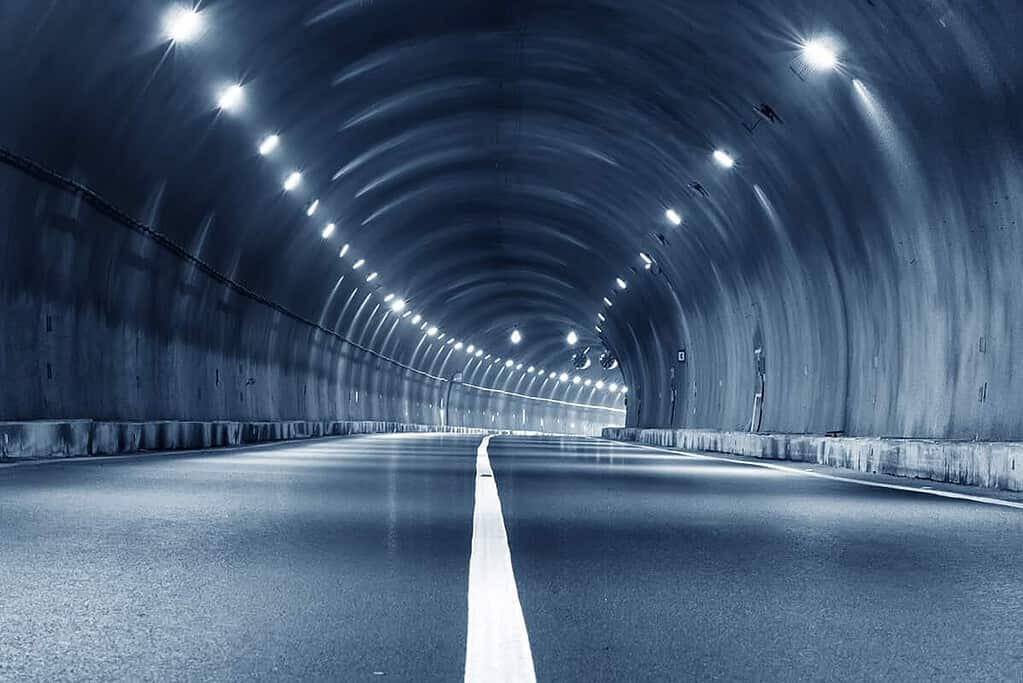
Ensuring Tunnel Safety and Efficiency with LED Lighting
Crucial Role of Tunnel Lighting for Safety and Efficiency
Using appropriate tunnel lighting is essential for maintaining safety and efficiency within tunnels, as it provides the necessary illumination for traffic flow. Enhancing visibility at entrances and throughout the tunnel reduces the likelihood of accidents. A well-lit tunnel ensures drivers can easily navigate through, minimizing potential hazards and promoting smooth traffic flow while maintaining optimal voltage levels.
LED Tunnel Lights: Energy Savings Galore
Switching to LED tunnel lights can result in significant energy savings compared to traditional lighting options. LEDs consume less electricity and have lower electrical resistance, reducing power consumption and operational costs. By opting for LED tunnel lights with lower voltage requirements, not only will tunnels be safer due to improved visibility, but they will also be more cost-effective in terms of energy usage.
Smooth Transitions: LED Lighting’s Edge Over Traditional Options
One challenge drivers face when entering a tunnel is adjusting from natural daylight to artificial light. With its voltage control and power supply, LED lighting offers better control over light uniformity and intensity, ensuring a smoother transition that ultimately leads to improved safety. With LED tunnel light providing consistent illumination throughout the tunnel, drivers can maintain their focus on the road ahead without struggling with sudden changes in lighting conditions.
Customizable Colors with RGB Light Tunnel Technology
RGB light tunnel technology allows for customizable color options in LED tunnel lighting systems. These colors, powered by an efficient power supply, can enhance visibility further, guide traffic flow or provide visual cues during emergencies.
- Red lights could indicate an accident or hazard ahead
- Green lights could signal a clear passage through the tunnel
- Blue lights might denote areas requiring extra caution
These customizable color options, provided by LED tunnel light, offer additional safety measures within tunnels while adding a visually appealing touch. The voltage and power supply ensure efficient performance.
Durability Meets Low Maintenance: The Winning Combination
LED tunnel lights are designed with durability, voltage, and low maintenance in mind, making them ideal for long-term efficiency within tunnels. Their high power output and resistance to harsh conditions require fewer replacements or repairs over time. This contributes to overall cost savings and ensures tunnels remain well-lit with minimal downtime.
Smart Control Systems: Maximizing Efficiency in Real-Time
Implementing intelligent control systems in LED tunnel lighting enables real-time monitoring and adjustment of light levels based on traffic conditions. This further improves energy efficiency by reducing unnecessary power usage when it’s superfluous, such as during periods of low traffic volume. By adjusting light levels to the current situation, tunnels can maintain optimal visibility while conserving energy.
To sum it up, LED tunnel lights and power supply provide numerous benefits for ensuring safety and efficiency within tunnels. From significant energy savings to customizable color options and intelligent control systems, these lighting solutions are a game-changer for modern tunnel infrastructure.
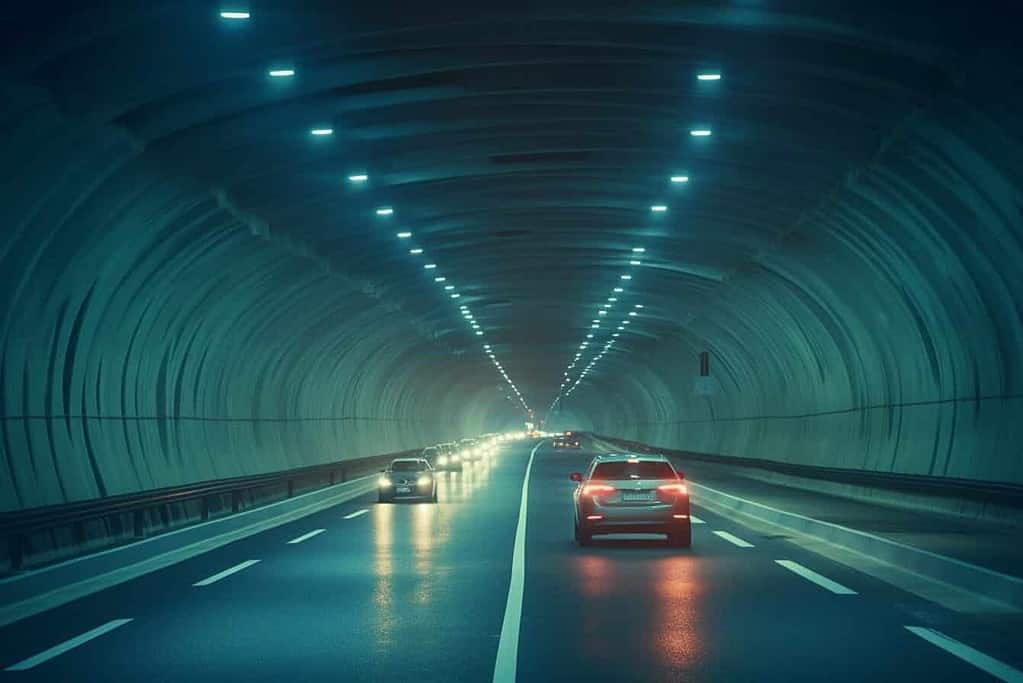
Guidelines for Tunnel Lighting Zones and Design
Mastering Access Zone Lighting
Access zones are crucial for a smooth transition from outdoor to tunnel conditions. LED tunnel lights with appropriate luminance levels and power supply must be installed in these areas, using strips if necessary, to help drivers’ eyes adapt to the change in lighting. The goal is to ensure that motorists can safely enter the tunnel without being blinded or experiencing discomfort due to sudden changes in brightness.
To achieve this, consider factors such as the length of the access zone, ambient light conditions outside the tunnel, and traffic flow patterns. Considering these aspects, you can design an adequate lighting system using led strips and a suitable power supply that provides optimal visibility and minimizes potential hazards.
Interior Zone Illumination Strategies
The interior zone is typically the most extended section of a tunnel, demanding uniform illumination for enhanced visibility. Strategic placement of LED tunnel light strips is essential to minimize glare and ensure a safe driving environment. Consider factors such as mounting height, spacing between fixtures, beam angles, and power supply when designing your lighting layout.
One way to optimize interior zone lighting is using indirect lighting techniques with LED strips. This involves positioning LED lights and their power supply to bounce off reflective surfaces like walls or ceilings before reaching motorists’ eyes. This method helps reduce glare while providing adequate illumination for drivers navigating the space.
Handling Threshold Zone Challenges
Threshold zones require higher luminance levels in LED tunnel lights due to the contrast between bright exterior environments and darker tunnel interiors. Ensuring driver safety means addressing this disparity by carefully selecting appropriate light fixtures and power supplies and designing a practical layout with LED tunnel lights.
When planning threshold zone lighting, consider factors like natural daylight penetration (especially at entrances), vehicle speed limits within tunnels, and potential sources of glare or reflections from led strips. Properly designed threshold zone lighting using a reliable power supply will enable drivers to maintain their focus on the road ahead while minimizing discomfort caused by abrupt changes in light levels.
Transition Zone Adjustments
Gradual adjustment of LED lighting levels, using power LED tunnel light, is vital in transition zones as drivers move towards exiting tunnels. Their eyes need time to adapt from lower illumination levels within the tunnel to brighter outdoor conditions. This can be achieved by designing a lighting system that gradually increases luminance levels as motorists approach the exit.
Consider traffic flow, vehicle speed, and ambient light conditions outside the tunnel when planning your transition zone lighting with led strips. By carefully considering these elements, you can create a seamless experience for drivers that reduces potential hazards and improves overall traffic flow while optimizing power usage.
Exit Zone Essentials
Adequately designed LED tunnel lighting in exit zones ensures smooth adaptation to outdoor lighting conditions, reducing potential hazards and improving overall traffic flow. Consider factors like mounting height, fixture spacing, beam angles, and power when designing your exit zone lighting layout to achieve this.
One practical approach is to use fixtures with adjustable output levels that can be fine-tuned according to changing ambient light conditions outside the tunnel. This allows for seamless integration between indoor and outdoor environments while maintaining optimal visibility for drivers on their way out of tunnels and efficiently managing power consumption.
By following these guidelines and considering each zone’s unique characteristics within a tunnel, you’ll be well-equipped to design an efficient LED tunnel lighting system that enhances safety, promotes smooth traffic flow, and optimizes power usage.
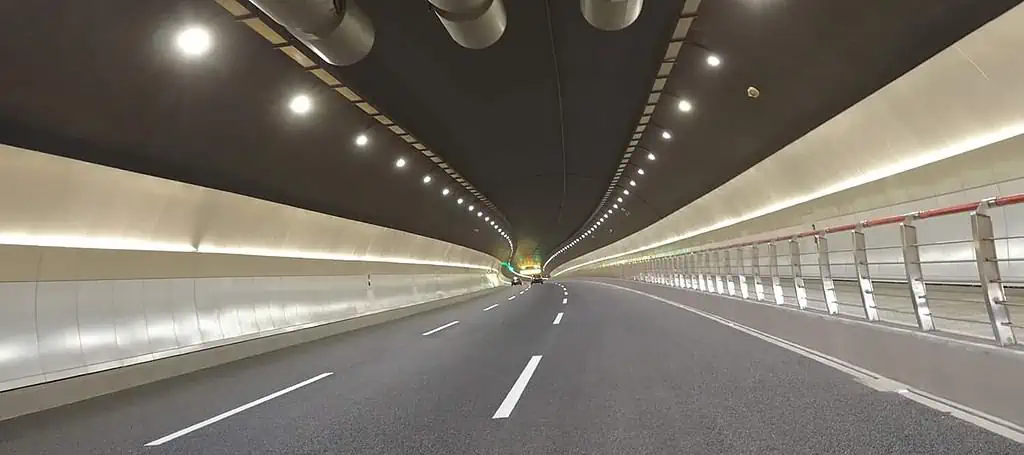
Choosing a Reliable LED Tunnel Light Manufacturer and Supplier
Inspecting LED Chip Quality: Crucial to Performance
One of the most critical aspects of selecting a reliable LED tunnel light manufacturer and supplier is assessing the quality of their LED chips and power strips. Top-notch chips ensure excellent performance, longevity, and energy efficiency in your lighting products. To make an informed decision, you should consider the following:
- The brand of LED chips used by the manufacturer
- The chip’s lumen output and efficacy (lumens per watt)
- Color rendering index (CRI) and color temperature consistency
- Resistance to heat and other environmental factors
By paying close attention to these factors, you can ensure that the LED tunnel lights you purchase will meet your performance, durability, and energy savings expectations.
Power Supplies Matter: Stability and Industry Standards
A stable power supply is vital for the optimal functioning of LED tunnel lights. Examining their power supplies closely is essential when evaluating potential manufacturers or suppliers. Key points to consider include:
- Compatibility with various input voltages and frequencies
- Efficiency in converting AC voltage to DC voltage required by LEDs
- Protection features, such as overvoltage, short circuit, and overtemperature protection, are essential when powering an RGB light tunnel.
- Compliance with industry standards like UL or CE certifications
Investigating these aspects will help guarantee that your chosen manufacturer provides power supplies that meet or exceed industry requirements while ensuring stable operation for your LED tunnel lights.
Digging Into Manufacturer Reputation: Background Check Time
It is crucial to research their background before committing to a specific manufacturer or supplier for your LED tunnel lights. This includes examining their expertise in producing high-quality products and understanding what previous customers have experienced. Some ways to gauge a company’s reputation include:
- Checking online reviews from verified clients
- Seeking recommendations from colleagues or industry professionals
- Investigating any awards or recognitions received by the company.
- Verify if they hold any patents on LED lighting technology.
By conducting thorough research, you’ll better understand the manufacturer’s ability to consistently deliver top-quality LED tunnel light products, including power and strips.
Support Matters: From Purchase to Maintenance
Finally, choosing a supplier that offers comprehensive support throughout your experience with their power products, such as LED strips and LED tunnel light systems, is essential. This includes technical assistance during installation, warranty on products and components, and after-sales services for maintenance or troubleshooting needs. Crucial aspects of product support include:
- Availability of customer service representatives via phone or email
- Clear communication regarding warranty terms and coverage
- Access to documentation such as installation guides and spec sheets
- Prompt response times for addressing issues or concerns
By selecting a LED tunnel light manufacturer that prioritizes customer support, you can feel confident in your investment and know knowledgeable professionals will promptly address any challenges.
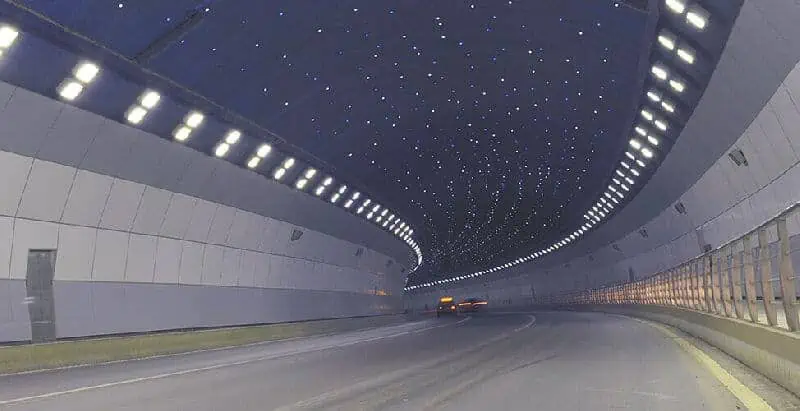
FAQs
Guidelines for tunnel lighting are like a recipe for a cake — precise, calculated, and designed to create a safe outcome. According to standards like the International Commission on Illumination (CIE), tunnel lighting should ensure safety, comfort, and ease of maintenance. The lighting should suit the tunnel length, location, and traffic conditions, considering aspects such as entrance lighting, threshold zone lighting, transition zone lighting, and interior zone lighting.
The L20 method is akin to a navigator’s compass — it guides the direction of lighting design. It is a calculation method used to determine the luminance required for the lighting of road tunnels. It’s based on factors like traffic speed, the width of the road, the reflectance of the surroundings, and the external luminance.
The lux level for tunnel lighting can be compared to the sugar in a recipe — it must be just right. Too little or too much can spoil the results. Depending on the specific area of the tunnel (entrance, interior, or exit), the lux levels can range anywhere from 1 lux up to 150 lux or more. Always remember the aim is to ensure a comfortable, safe transition for the eyes from the external lighting conditions to the tunnel’s interior.
The orange light in a tunnel can be likened to a lighthouse beacon on a foggy night — it’s designed to cut through harsh conditions. This warm-hued light, often sodium vapor light, has been traditionally used in tunnels because of its high luminous efficacy and ability to penetrate fog. However, with technological advancements, white LED lamps are increasingly replacing these due to their energy efficiency and superior color rendering.
The NFPA (National Fire Protection Association) code for tunnels resembles a safety manual. It includes NFPA 502, which defines road tunnels, bridges, and other structures’ fire protection requirements. It covers aspects like emergency exit design, ventilation, and lighting, which are critical in any emergency.
The lighting rules can be compared to the rules of a board game — they create a structured and enjoyable experience. Some general rules include ensuring suitable illuminance for the task, providing uniform lighting, avoiding glare, and considering the color temperature. Of course, these rules will be tailored to specific environments like homes, offices, or tunnels.
Guidelines for lighting safety are like traffic rules — they prevent accidents and ensure everyone’s well-being. This includes providing enough illumination for tasks, avoiding direct glare, ensuring emergency lighting is in place, using lights with the correct IP rating for the environment, and regular lighting system maintenance and checks.
Guidelines for good artificial lighting are akin to the principles of a well-composed photograph — they make the result more appealing and functional. These guidelines may include using appropriate brightness (lux level), ensuring even light distribution, minimizing shadows and glare, and choosing the right color temperature for the setting.
Recommended standards for lighting are like a well-marked hiking trail — they guide you to your destination safely and comfortably. Different tasks and settings require different light levels, measured in lux. For example, simple orientation for short temporary visits may require only 20-50 lux, while tasks of high precision and detail may require up to 2000 lux. A professional workspace typically requires around 500 lux.
The best lux level is as variable as the setting on your thermostat — it depends on the circumstances. As mentioned above, it can range from 20 lux for a simple orientation to 2000 lux for precision tasks. For most office work, around 500 lux are usually adequate.
Determining how many lux is enough is like deciding how much spice to put in a soup — it depends on what you’re cooking up. For general living spaces, 100-200 lux is typically sufficient. 300-500 lux or higher might be necessary for more detailed tasks like reading or precision work.
The standard lux range can be compared to a piano’s keys — there’s a wide range, and different keys (or lux levels) are used for various purposes. It can be as low as 20 lux for a simple, low-activity environment and up to several thousand lux for locations requiring great detail and precision, such as operating theatres in hospitals.
Conclusion: The Ultimate Guide to LED Tunnel Lights
It’s crucial to understand LED tunnel lighting features for making intelligent choices. These long-lasting, eco-friendly lights come in various types for different tunnel applications. Selecting the right LED light involves considering factors like wattage, lumens, color temperature, and beam angle. Proper layout and optical design ensure optimal illumination, minimizing glare and shadows while balancing safety, efficiency, and aesthetics. Tunnel safety is a top priority, so following lighting guidelines for different zones ensures adequate visibility for drivers.
